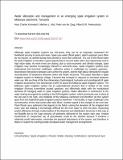| dc.description.abstract | Although spate irrigation systems are risk-prone, they can be an important component for livelihood security in semi-arid areas. Spate uses water (flood water), which upstream users often do not require, as rainfall during these periods is more than sufficient. The use of this flood water for spate irrigation is therefore a good opportunity to convert water with a low opportunity cost to high value water. As more rivers are closing, due to socio-economic and climate changes, spate irrigation may become increasingly relevant in semi-arid areas. Spate irrigation systems pose institutional and technical challenges: collective action is challenged by complex upstream–downstream interactions between users within the system, and the high labour demands for regular reconstruction of temporary diversion weirs and intake structures. This paper describes a spate irrigation system in Makanya village, Tanzania that emerged in response to increased upstream water use. We use three of the four dimensions (hydrological, hydraulic and sociological) of spate irrigation proposed by Van Steenbergen (1997) to assess the Makanya spate irrigation system. The Makanya spate irrigation system has an organisational structure that is similar to the canal irrigation (furrow) committees located upstream, and effectively deals with the institutional demands of managing water in spate irrigation systems. Water allocation is reminiscent to the water sharing arrangements existing in the full irrigation system, which previously was in place at the site and in the high- and midlands of the Makanya catchment and therefore set this system apart from the traditional spate irrigation practice elsewhere. Technically, a major challenge is the reconstruction of the head works after each flood. Another aspect is the changes in the river bed. Flash floods carry sediments that deposit on the fields, raising the elevation of the irrigated land every year and making it increasingly difficult for the river water to enter the plots. Improving system efficiency through modernisation of the diversion and distribution structures in this case is not feasible due to the huge amounts of sediments delivered to the system each year. Instead investments in conjunctive use of groundwater could be the solution because it involves a relatively small intervention, minimises the physical disturbance of the system, and therefore is likely to respect the existing locally developed water management arrangements. | en_US |

